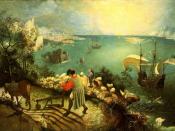Icarus is a character in Greek myth who while flying with wings of wax and feathers made by his father, attempted to escape King Minos. Icarus being caught up in the glory of his flight, does not heed his father's warnings and flies too close to the sun; the wax melts from his wings and he plummets into the sea and drowns. This myth appears to be very straight forward and yet four poets write poems expressing four different perspectives using specific techniques. Using the four poems, "To a Friend Whose Work Has Come to Triumph" by Anne Sexton, "The Return of Icarus" by David Wagoner, "The New Icarus" by Vassar Miller and "Landscape with the Fall of Icarus" by William Carlos Williams, I will attempt to explore these poems use the process of explication.
Sexton's poem gives us a retelling that takes us "down to earth" in its search for the reality behind the mythical tradition.
Her poem becomes a modern counter-myth in which the ancient story becomes the mythologized and original heroes become the modern antiheroes. Sexton uses a tone irreverent toward both gods and human beings and uses a symbolism of heroism in her poem.
Wagoner attempts to change the story to make the myth more believable with its modern day twist. In retelling this story, the portrait of the father is one that has capitalized off the fame of his invention not taking a second to grieve over the loss of his son.
The New Icarus seems to have a religious symbolism. In Miller's poem, according to one student, "the new Icarus is Christ." In line 9 when the poet mentions, "your wreck of bone," he is speaking of finding salvation through suffering. This student may have come to this conclusion because line 12...


